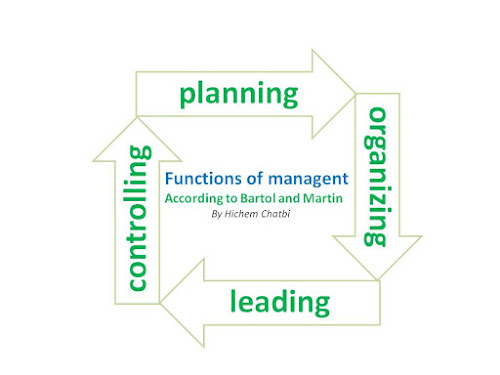Functions of Management
Management includes connected activities, functions or consecutive processes, aimed at implementing the mission of the organization, and achieving its objectives and vision or future ambition.
Every thinker sees and classified management functions in his own perspective, but there are common points in their views.
According to George & Jerry, “There are four fundamental functions of management i.e. planning, organizing, actuating and controlling”.
According to Henry Fayol: planning, organising, commanding, coordinating, controlling.
According to Whereas Luther Gullick :
He summarized management functions in the word ’POSDCORB’
P for Planning
O for Organizing
S for Staffing
D for Directing
Co for Co-ordination
R for reporting
B for Budgeting
According to KOONTZ and O’DONNEL
The management functions are Planning, Organizing, Staffing, Directing and Controlling.
According to Bartol and Martin
to achieving organizational goals we need to engage in the four functions of planning, organizing, leading and controlling.
Each function is related to other functions.
We will now explain these functions:
Planning
the planning is Primary Function and process of determining the objectives and goals of the company and the ways and plans to achieving it using the resources properly.
According to KOONTZ, “Planning is deciding in advance what to do, when to do and how to do.
According to Urwick, “Planning is a mental predisposition to do things in orderly way, to think before acting and to act in the light of facts rather than guesses”
According to Henri Fayol, using a good plan of action is the harder function in management. because the planning requires the active participation of all teams and requires to respecting the time and implementation, planning must be linked to and coordinated on different levels.
According to Killen, “Planning is the process of deciding in advance what is to be done, who is to do it, how it is to be done and when it is to be done”.
Organizing
Organizing is the function of bringing the necessary resources, create a relationship between them and dividing work, for example, the agent X will manage the machine Y, or the team X will do the mission Y under the supervision of the manager Z.
According to Louis A. Allen, “Organisation is the process of identifying and grouping of the works to be performed, defining and delegating responsibility and authority and establishing relationships for the purpose of enabling people to work most efficiently”.
According to Chester Barnard, “Organizing is a function by which the concern is able to define the role positions, the jobs related and the co-ordination between authority and responsibility”.
Staffing
It is the process of managing the structure of the organisation and put the right employees on the right jobs, evaluate and develop them.
according to Kootz & O’Donell “the staffing function involves manning the organization structure through the proper and effective selection, appraisal and development of personnel to do the roles designed in the structure”.
according to Caruth, Caruth and Pane “Staffing is a process through which an organisation ensures that it has, on a continuous basis, the proper number of employees with the appropriate skills in the right jobs at the right times to achieve the organisation’s objectives.”
according to Heneman, Judge and Kammeyer-Mueller “Staffing can be defined as the process of acquiring, deploying and retaining a workforce of sufficient quantity and quality to create positive impacts on the organisation’s effectiveness.”
according to W. Haynes ‘Staffing is the process of analyzing the jobs of an organization in terms of manpower needs, recruiting and selecting candidates to fill them.’
Staffing includes:
-Planning and estimating the manpower in terms of searching, select and recruit the right person for the right mission.
-Motivating, training and Development.
-Evaluation of performance and skills.
-Promotion and Transfer.
-Making changes among workers, or employing new workers in the event of an emergency.
Directing
it is a practical function Because in the directing process the administration will apply what it has planned.
In this function, superiors will communicate, supervise, directing and monitoring worker performance and motivate them more to do their work effectively.
controlling
Evaluating the work and making sure that the goals have been
achieved as planned, or is the company on the right way to achieving these
goals.
in this process, the organization will use the standard performance (expected), actual performance (real) and Compare between them and finding out deviation.
if the organization discovers that the current strategy has achieved its pre-determined goals, it begins to plan again to develop other goals.
if the organization discovers that the current strategy cannot achieve the pre-determined goals, it will begin to correct the strategy and start again from planning.
According to Brech, “Controlling is a systematic exercise which is called as a process of checking actual performance against the standards or plans with a view to ensure adequate progress and also recording such experience as is gained as a contribution to possible future needs.”
According to Koontz & O’Donell “Controlling is the measurement & correction of performance activities of subordinates in order to make sure that the enterprise objectives and plans desired to obtain them as being accomplished”.
a small example to explain controlling :
standard performance (expected) is to selling 1000 units
actual performance (real): the company sold 1000 units
1000/1000= 1
Goal achieved
standard performance (expected) is to selling 1000 units
actual performance (real): the company sold 800 units
800/1000= 0.8
The goal was not achieved







Comments
Post a Comment